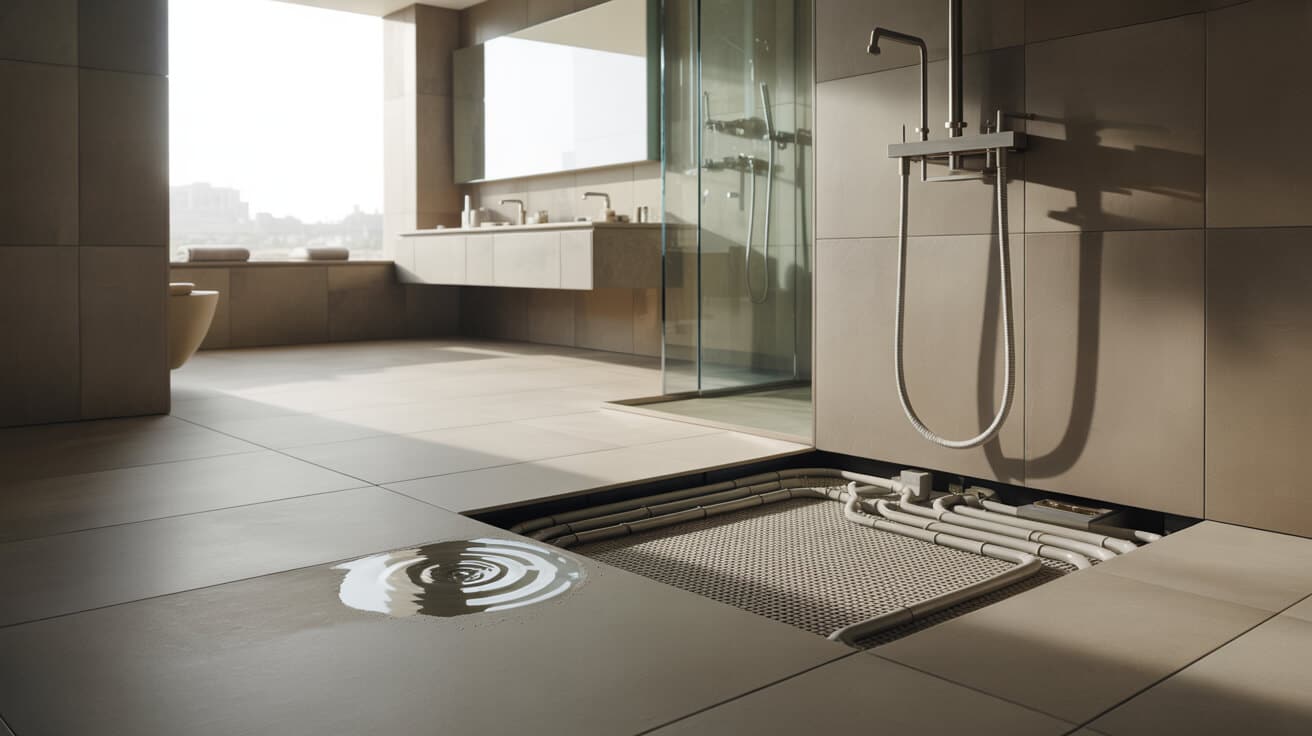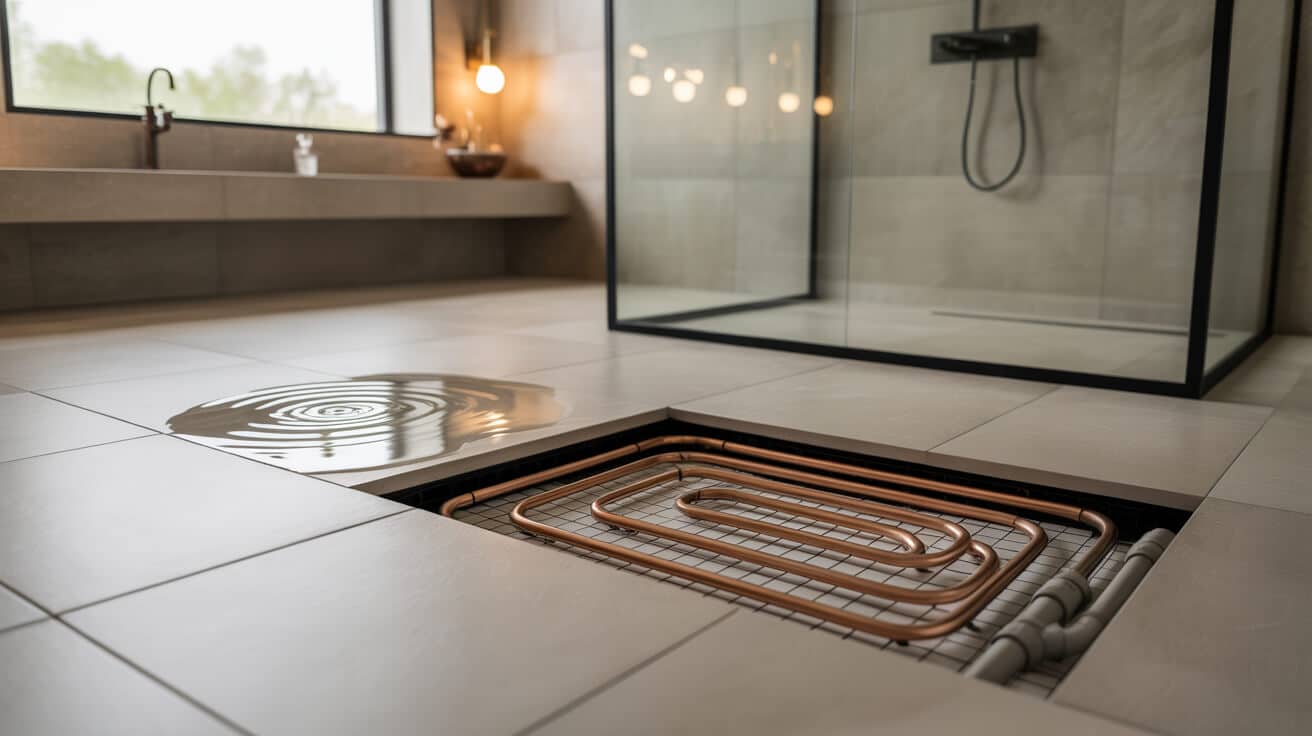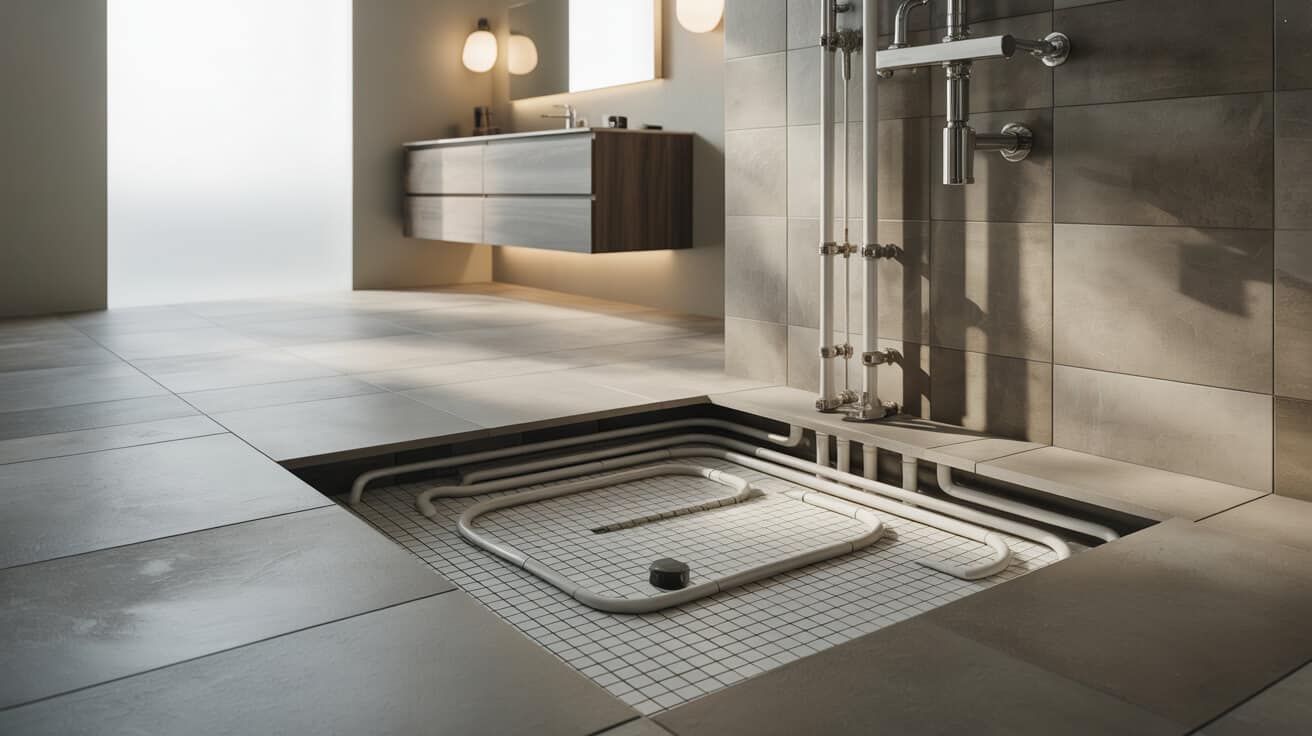Underfloor heating networks are designed for unobtrusive, efficient climate control beneath floors in residential, commercial, and institutional properties. While energy distribution is inherently quiet, system noise signals a deviation from optimal functioning and may serve as an early warning of maintenance needs, component failures, or installation errors. For companies such as Plumbers 4U, promptly identifying and resolving these acoustic patterns demonstrates expertise, safeguards client trust, and upholds compliance requirements.
Etymology or Name Origin
The phrase “underfloor heating system noise” merges three technical domains: “underfloor” signifying placement beneath finished flooring; “heating system” specifying the method of whole-room or zone conditioning; and “noise” referencing the presence of unwanted sound. Industry practitioners differentiate between ordinary operational sounds, such as mild expansion clicks or water circulation, and those associated with malfunction, using terminology like “gurgling” (air in lines), “water hammer” (sudden pressure shifts), and “resonance” (structural or mechanical vibration).
Overview / Context
Underfloor heating has become common in both new-builds and retrofits due to its space efficiency, even heat distribution, and perceived luxury. System noise undermines these advantages. In residential spaces, comfort is paramount; even faint recurring sounds can disturb sleep or work, creating latent dissatisfaction. In rented or managed properties, unresolved acoustic complaints can escalate to disputes over habitability. Commercial environments, such as hotels or offices, experience noise as an operational risk—damaging reputation and, for facilities managers, signalling deeper infrastructure issues with repercussions for service continuity. Across contexts, property insurers sometimes consider persistent noise evidence of neglect, raising stakes for your organisation.
Expectation for operational silence results from advances in system commissioning, design, insulation practice, and the evolution of customer preferences. Within competitive sectors, superior acoustic performance is a subtle but strong differentiator among service providers.
History
Origins
Radiant heat delivery beneath floors was first recorded in ancient Korea and Rome, with hypocausts and ondol systems providing continuous warmth. Despite their effectiveness, early systems lacked the insulation, material science, and hydraulic control found in modern builds. Their function was silent for lack of moving parts, but heat-up times and poor control often led to inconsistent comfort.
Industrial Emergence
The twentieth century brought hydronic (water-based) and, later, electric radiant floors to wider adoption. The introduction of closed loops, synthetic piping, and thermostatic controls established underfloor heating as an efficient, scalable alternative to radiators. Acoustic concerns appeared as a secondary challenge, often addressed only after installations were complete and occupants reported bothersome sounds.
Contemporary Evolution
With energy crises and regulatory focus on efficiency, underfloor heating systems gained traction through advances in control technology, pump and valve design, and floor construction. Quiet operation became formally recognised in technical documentation and standards, notably EN1264 in Europe and a variety of best practices referenced in the UK’s Building Regulations (Parts L, G3, E). Modern emphasis on commissioning, balanced flow, and post-installation testing marks a shift toward noise prevention rather than reactive mitigation.

Concept / Description
Underfloor heating, known as UFH, relies on either water-carrying pipes (hydronic) or resistive electrical cables/mats installed below the finished flooring. Hydronic systems circulate water, typically heated by a boiler or heat pump, through a network connected by manifolds, pumps, and actuators. Electric systems pass current through cables or mats, delivering heat directly with fewer moving parts but different acoustic profiles.
Pipes or cables are generally embedded in a screed or insulation layer, underneath floor coverings chosen for thermal and acoustic performance—wood, tile, stone, vinyl, or laminate. A balanced system design requires careful calculation of flow rates, insulation, control zoning, and pressure management, all of which influence sound levels.
Core Components
- Pipework/Cables: Materials affect heat transfer and resonance; PEX and polybutylene predominate for their flexibility and sound-dampening qualities.
- Manifolds: Distribution hubs balancing zones, where noise may arise from imbalanced flows, air pockets, or mechanical wear.
- Circulation Pumps: Potential sources of hum or whirring, especially if oversized, under-lubricated, or improperly mounted.
- Mixing/Blending Valves: Regulating water temperature, potentially emitting whistling or chattering when obstructed.
- Actuators/Zone Valves: Control devices for each room or space which can buzz, click, or grind, especially with end-of-life wear.
- Insulation, Screed & Substrate Layers: Influence both heat transmission and vibration absorption.
Functionality / Purpose / Applications
The purpose of underfloor heating systems is to provide consistent, space-efficient warmth across floor surfaces, replacing radiators or air-based heaters. Dependent on property scale, your company may instal such systems:
- In homes (for comfort and aesthetics)
- In commercial sites (minimising visual clutter and maximising usable real estate)
- In sensitive environments (e.g., nursing homes, childcare facilities, museums) where even low-level noise could create operational or reputational challenges.
Their intended outcome is always silent or near-silent operation, enabling end-users to perceive only the comfort of radiant heat, not the machinery beneath. The only consistent exception is during system start-up or balancing, during which minor and brief sounds are considered acceptable by most standards.
Classifications / Types / Variants
Hydronic Underfloor Heating
Hydronic (wet) systems are most common in larger, multi-room installations and new-builds. They rely on water heated by a central plant and pumped through polyethylene or polybutylene pipes. This system type is most susceptible to airlocks, flow compensations, and mechanical noise if improperly commissioned.
Electric Underfloor Heating
Electric (dry) systems consist of mats/cables that directly convert electrical energy into radiant heat. Electrical relay “clicks” or thermostat switching are possible sound sources, but hydraulic phenomena (like gurgling) are absent. Electric systems are favoured for retrofits or small-zone applications due to ease of installation and less complexity in balancing.
System Layouts and Zoning
- Single-zone: Serves one space or open plan.
- Multi-zone: Separates areas for optimised control and load balancing, but introduces more actuators and valves, increasing potential sound sources.
- Retrofit vs. New Build: Retrofitted systems often face more acoustic challenges due to sub-floor constraints, older substrate irregularities, or mismatched materials.
Materials
The choice of pipe, mat, or insulation directly informs both thermal efficiency and acoustic character. Table of typical properties:
| Material | Common Use | Acoustic Profile |
|---|---|---|
| PEX Pipe | Hydronic, new | Low resonance |
| Polybutylene | Hydronic, retrofit | Flexible/quiet |
| Copper | Legacy instal | High resonance |
| Electric Mat | Electric, retrofit | Relays only |
| Insulation Bd. | Both | Noise-damping |
Systems / Tools / Methodologies
Installation and Commissioning
- Air Purge/Bleed: Systematically remove trapped oxygen to prevent gurgling and pipe vibration.
- Flow Balancing: Adjusting each circuit for even distribution minimises water turbulence and valve chatter.
- Insulation Placement: Correct installation of floor and wall insulation absorbs vibration and decouples pipes from substrate resonance.
- Calibrated Component Sizing: Proper matching of pumps, valves, actuators to design loads ensures stable operation without excessive force or sound.
Diagnostic and Service Tools
- Acoustic Stethoscopes: Allow pinpoint identification of noise origins without destructive exploration.
- Thermal Imaging Cameras: Visualise blockages, airlocks, or cold spots.
- Pressure and Flow Metres: Quantify systemic imbalances leading to flow noise and potential water hammer.
Service and Remediation
Routine maintenance contracts, such as those offered by Plumbers 4U, can be engineered to include annual acoustic checks and real-time noise monitoring, providing your company with confidence about underlying issues before they escalate.

Stakeholders / Entities Involved
Homeowners
Value quality of life, property protection, and clarity on when a noise crosses the line between “quirky system” and actionable fault. Engaged homeowners will often be the first line of detection, reporting on new or changing sound patterns.
Landlords & Managing Agents
Require fast, compliant, and defensible response protocols in the face of tenant noise complaints, ensuring regulatory and legal risk is mitigated. Sound issues left unresolved can result in claims for rent reduction, formal habitability challenges, or insurance involvement.
Facilities Managers & Commercial Site Directors
Tasked with maintaining comfortable conditions for large user populations, their perspective merges performance, cost, and compliance. Disruptions from noise can be reputational, impacting the commercial value of a property, or operational, resulting in downtime.
Engineers, Installers, Manufacturers
Professionals bear the duty to design, instal, diagnose, and remediate under the umbrella of compliance and safety standards, using comprehensive documentation. Manufacturers like Plumbers 4U reinforce their reputations through diagnostic routines, detailed technical documentation, and warranty support.
Regulatory and Inspection Bodies
Building control officers, inspectors, and regulators operate as oversight authorities, ensuring your compliance by referencing building codes, manufacturer documentation, and field performance metrics.
Legal / Regulatory / Ethical Considerations
Statutory Codes and Standards
- UK Building Regulations:
- Part L: Conservation of fuel and power, including pressure loss and control.
- Part G/G3: Hot water supply and unvented cylinder safety.
- Part E: Sound insulation and acoustic propagation minimums.
- EN1264: Performance standard for testing water-based underfloor heating and cooling, including many methods for controlling and documenting noise.
Certifications
- WaterSafe, WRAS: Mandatory for any system connected to the public water supply.
- G3 Certification: Required for handling unvented cylinders or any pressurised hot water, ensuring safety and limiting sound-linked hazards.
Tenant and Occupant Rights
Tenants can demand rectification if system noise renders the property less than “fit for occupation.” Unaddressed acoustic issues can lead to abatement in rent or enforcement actions. You and your organisation are legally and ethically bound to maintain operational sound in accordance with lease agreements and local law.
Ethical Practice
Service providers must ensure honest diagnosis without manipulating technical ambiguity to upsell unnecessary services. Plumbers 4U internal guidelines highlight clear reporting and transparent communication as integral to ethical compliance.
Performance Metrics / Data / Measurements
Benchmarks
- Acceptable noise thresholds: typically fall below 25dB at 1-metre horizontal distance in inhabited zones, measured during steady-state operation.
- Peak events: (e.g., actuator shutoff, pump start) are tolerated up to 30–35dB provided they do not occur frequently.
Measurement Procedures
- Decibel metres: Used during field surveys to profile acoustic landscape pre- and post-intervention.
- Thermal imaging & logging: Plumbers 4U recommends imaging at service intervals to establish baseline, catch silent airlocks, and spot thermal imbalance that may not yet have a sound correlate.
- Incident reporting systems: Record descriptions, frequency, perceived loudness, and situational triggers for all stakeholder reports.
Documentation & Warranty
- Intervention logs: Every visit, diagnosis, and step taken must be recorded. Building insurers and arbitrators use these logs to adjudicate disputes.
- Warranty support: Most manufacturers’ coverage is conditional on documentation and following best diagnostic practices.
Challenges / Barriers / Limitations
Technical Barriers
- Historic/Listed Buildings: Limitations on floor excavation or insulation upgrades increase resonance risk.
- Mixed legacy systems: Combining new UFH with older radiators or heating plant may exacerbate hydronic noise unless carefully balanced.
- Material Sourcing: Inconsistent supply chains for pipes, insulation, or actuators sometimes force substitutions, increasing the risk of incompatibility and new sound artefacts.
Economic and Social Obstacles
- Remediation cost: Uncovering and solving embedded system faults can be disproportionately expensive relative to system replacement, influencing the decision for proactive maintenance.
- Disruption: Floor lifting or zone isolation disrupts occupants or operations, creating an aversion to early intervention.
Communication and Documentation
Engineers may document complex findings in technical language that non-expert owners or tenants find inaccessible, resulting in confusion, distrust, or repetitive call-outs unless translated by a service provider with customer-centric protocols like those of Plumbers 4U.
Impact / Influence / Legacy
Sustained Comfort and Value
Maintaining silence produces tangible and intangible benefits for your property—maximise tenant/occupant satisfaction, minimise complaint escalations, and support strong market positioning in competitive lettings. Transparent acoustic documentation improves resale or lease confidence and streamlines insurance claims.
Industry and Technical Evolution
Increasing sophistication in pipes, valves, and digital controllers, together with robust quality assurance routines, push the industry toward preventing noise at the design stage. Sector reputation increasingly hinges on “invisible,” frictionless systems where silence signals both competence and care.
Lessons from the Field
Remediation failures in public facilities, care homes, or premium residential settings often yield landmark insurance cases or shape new compliance benchmarks, feeding back into guidance delivered both by regulators and proactive companies such as Plumbers 4U.
Future directions, cultural relevance, and design discourse
Digital Acoustic Analytics and Remote System Management
The next phase of system service will harness embedded microphones, vibration sensors, and cloud-based acoustic analytics, enabling real-time diagnosis and early warning before occupants detect an issue. Proactive alerts not only preserve comfort but also optimise engineering response, reducing rectification costs.
Lowered Acceptable Thresholds and Regulatory Advance
Building codes will likely further constrain acceptable decibel levels, and explicit post-installation certifications will become common, elevating silent operation from “nice-to-have” to a statutory requirement—particularly in rental or vulnerable tenanted sectors.
The Social Value of Silence
Culturally, as living and working spaces densify, “quiet comfort” is expected, not requested. Silence itself becomes a premium feature. Design debates pivot on integrating radiant heat with acoustic damping not only in premium markets but also in affordable housing, schools, and social care spaces. Innovators in the industry aim to normalise these holistic design values for all.
Dialogue and Responsibility
Who is accountable—and when—is increasingly adjudicated in property law, lease agreements, and insurance proceedings. Forward-thinking professionals, property managers, and organisations like Plumbers 4U routinely pre-empt disputes through documentation, pre-letting certifications, and post-instal care protocols, ensuring the lasting value and utility of the built environment.

